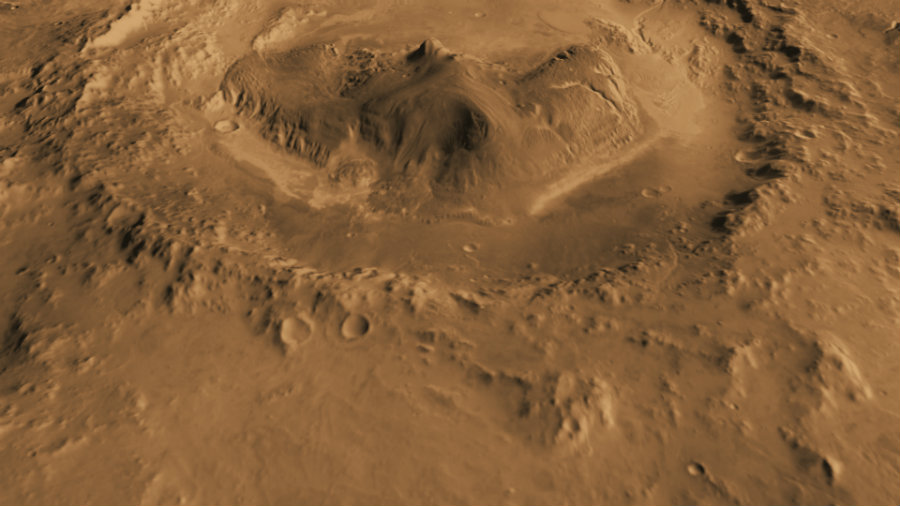Researchers discovered that the Gale Crater on Mars once harbored a lake, in which life could have thrived.
They analyzed sediments and found the chemical traces that differentiate a lake’s deep water from its shallow water, just like on Earth.

Apparently, the lake was fed by freshwater rivers, and it existed for an extended period while also displaying a very vivid chemistry.
Mars was habitable in the past
The findings were made by NASA’s Curiosity rover, whose primary purpose is to determine whether Mars could serve as a habitat for life. The rover landed in Gale crater, as NASA researchers believed that it would be useful to survey Mount Sharp which is nearby.
Mount Sharp is comprised of layered sedimentary rock, which could serve as a sample of the geological changes that the crater and its surroundings have endured through time.
By analyzing the rocks gathered by Curiosity, researchers found that Mars has seen at least two major climate transitions. It seems that the planet was first freezing, and then warmed to conditions where life could have flourished on its surface. Eventually, the planet dried up, and its atmosphere disappeared.
Despite the findings, the Curiosity team was unable to draw accurate conclusions on the characteristics of Martian climate, mainly because all the existing data corresponds to observations made on Earth. They theorize that some of the rocks saw icy conditions at some point in the planet’s history, while other rocks were affected by warmer climates.
They concluded that the Gale crater could have harbored life at some point in history, between 3.8 and 3.1 billion years ago. Researchers agree that at some point, Mars had all the necessary ingredients to host an environment where life as we know it could have existed.
In 2012, through the analysis of Martian soil, Curiosity found that Mars had water molecules, alongside sulfur, chlorine, and even organic compounds, although they could have been the result extraplanetary contamination. One year later, Curiosity detected “abundant, easily accessible” water in the Martian soil.

The current discovery precedes back from 2013 when NASA determined that the Gale Crater had to contain freshwater at some point and that it was likely to have harbored microbial life in the past.
The observations were confirmed on June 1, 2017. The rocks obtained by Curiosity revealed that the lake was stratified, and its chemistry varied depending on its depth.
“Previously reported detections of organic carbon compounds, nitrogen, phosphate minerals, and Fe and S minerals in a variety of redox states, combined with the evidence presented here for relatively stable climate conditions and gradients in fluid oxidation state, provide compelling evidence that all of the physical, chemical, and energetic conditions necessary to establish a habitable environment were present on Mars between ~3.8 billion and 3.1 billion years ago,” reads the study.
Currently, Curiosity is still surveying the Gale crater to uncover more mysteries about the planet’s composition and climatic history.
The Gale crater is 96 miles wide. It was named after Walter Gale, an Australian astronomer who observed Mars in the 19th century. It is believed to have formed after a meteorite impacted the planet, ejecting rocks all around the crater’s surroundings.
Curiosity landed on Mars in 2012, at the base of Mount Sharp, below Martian “sea level.” Researchers chose the Gale crater because of its many indications that water could have existed at several points of its history.
Mount Sharp, on the other hand, is a mound made out of layered material that has taken form over the course of 2 billion years.
The discovery of the remnants of a habitable Mars can work alongside the observations revealing that Mars lost its magnetic field between 4 and 3.8 billion years ago, resulting in the loss of its atmosphere and its water.
Researchers are now aiming towards finding more evidence to ensure a plausible theory. They require samples from the whole planet, not just a crater, to fully confirm that Mars could harbor life.
Curiosity is only the first step, ExoMars will launch in 2020
The next effort into finding more signs of life is the launch of the ExoMars Mission in 2020, delivering a rover that will roam the Martian regolith in a search for life. Similar to Curiosity, the ExoMars rover will drill the landscape and collect samples.
The ExoMars rover will land near a place that could potentially reveal secrets about the early history of the planet. It will dig to a depth of two meters, and it will analyze the minerals in the hole by using an infrared spectrometer.
Curiosity was designed as a predecessor of the Mars 2020 rover. To date, Curiosity has been on Mars for over 1758 Earth days or 1711 Martian sols since it landed on August 6, 2012.
Source: Science
